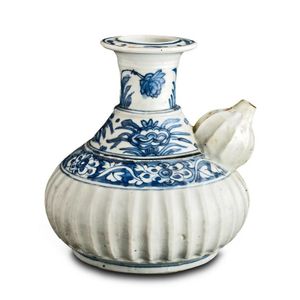Twin-Headed Phoenix Ewer from Song Dynasty
You must be a subscriber, and be logged in to view price and dealer details.
Subscribe Now to view actual auction price for this item
When you subscribe, you have the option of setting the currency in which to display prices to $Au, $US, $NZ or Stg.
- Ewer / Pitcher - A type of jug with a narrow neck bulbous body and wide spout, originally used for carrying and storing liquids such as water or wine. In medieval times they were the source of water to wash ones hands during and after a meal. later the shape was used for vessels in silver, gold, glass and ceramics.
In Victorian times they were made in ceramics and occasionally glass with a matching basin, and sometimes other accessories such as a soap holder or toothbrush holder. Their purpose was to provide facilities for personal washing In the early 19th century were often enclosed in purpose built stands, and later resided on a washstand..
Sometimes the words "ewer" and "pitcher" are used interchangably, but a pitcher is generally considered to be a jug, and would have a wide mouth, and a gently tapering body. - Song Dynasty - The Song Dynasty was a ruling dynasty in China from 960 to 1279 AD. It was divided into two periods, the Northern Song (960?1127) and the Southern Song (1127?1279). The emperor was the ultimate authority, but he relied on officials who were selected based on their merit and skills rather than their family background or social status. The Song Dynasty was a period of great artistic and cultural achievements, particularly in the areas of poetry, painting, and calligraphy. The Chinese invented the printing press during this period, which revolutionized the spread of knowledge and ideas. During the Song Dynasty, China had a prosperous economy and was a centre of international trade, particularly in luxury goods such as silk, tea, and porcelain. The use of paper money became more widespread during this period, facilitating commerce and trade.
This item has been included into following indexes:
Visually similar items

Belleek porcelain vase, with spreading lip and baluster body, decorated with grape vine motifs in yellow on a white ground, green mark, height 17.5 cm

A rare Chinese blue and white kendi, late Ming dynasty, 17th century, moulded in three floral decorated horizontal bands, with ribbed body and spout, 18 cm high

Belleek porcelain ewer, applied floral decoration, green sixth mark to base. Height 23 cm

A 'famille-rose' 'butterfly' vase mark of Guangxu the globular body rising to a trumpet neck, decorated in iron-red and 'famille-rose' enamels with numerous butterflies in flight, divided by a frieze of detached stylised lotus sprays and shou characters ar
